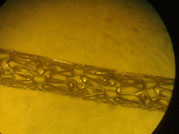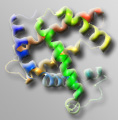|
|
|
| |
| |
| |
| |
| |
| |
 |
|
 |
|
| |
|
 |
 |
 |
 |
 |
 |
| |
|
|
ÂÑÑ-ÂÑ
deposited
Diamond Like Carbon (DLC) ultra thin and thin
films and nano coatings on different substrates,
such as :
** SS-316 LMV,
** Teflon,
** Ceramics,
** Semiconductor materials for infrared optics
(Si, GaAs, Ge and ZnSe as well.).
Cardiovascular Implants (stents) made of SS-316
and Nitinol have been coated by ultra thin and
thin film ta-C and a-C
types of DLC .
Further
development of the technology resulted in obtaining
ultra hydrophobic hybrid material - polymer (teflon)/DLC,
coated as thin and ultra thin films on metal substrate
- SS 316 LVM Stent.
The quality of the deposited films and the properties
of the new material have been examined. |
|
|
| non-coated
stainless steel surface |
DLC
coated stainless steel surface |
Human
immune-competent blood cells after 30 min under
arterial shear conditions |
|
|
DLC
coated SS 316 LVM Stent |
|
DLC
coated Nitinol Stent |
|
Teflon
DLC coated |
|
Teflon
graft DLC coated |
|
Teflon
/ ta-C DLC coated |
|
|
| |
|
 |
 |
 |
 |
 |
 |
| |
|
|
Metal
nanoparticles of Silver and Platinum have been
incorporated within the DLC matrix coatings on
cardiovascular stents.
Researchers published info that "...DLC-silver
and DLC-platinum composite films reveals ... self-assemble
into particulate nano composite structures that
possess a high fraction of sp3-hybridized carbon
atoms. DLC-silver-platinum films demonstrated
exceptional antimicrobial properties ."
|
|
|
MDLC
coated Stent and
nonCoated Stent
|
|
|
| |
 |
 |
 |
 |
 |
| |
|
|
Radiopaque Stent
|
BCC-BC
has developed and manufactured a radiopaque stent.
SS 316 LVM stent has been coated by thin film -
50 nm ta-C type of DLC and
within the same process metal nano particles of
platinum have been incorporated within the DLC structure.
By standard X-ray procedure, two sample stents coated
by DLC and by MDLC have demonstrated substantially
different radiopaque capabilities - MDLC is better
visible under x-ray.
Radiopacity is one of the key considerations in
the design of various devices such as stents that
are used during radiological control on cardiovascular
intervention. |
|
|
MDLC
coated and
DLC coated Stents
|
|
|
| |
 |
 |
 |
 |
 |
| |
|
|
ÂÑÑ-ÂÑ
has developed a new applied technology for deposition
of ultra thin and thin films DLC (a-C and ta-C types)
on Nitinol stent.
|
|
|
DLC
coated Nitinol Stent
0.1 and 10 microns resolution
|
|
|
| |
|
| |
 |
 |
 |
 |
 |
| |
|
|
Depositing
thin and ultra thin films of polymer P-312 (our
designation), from the family of phosphonats on
ceramic and metal substrates, besides known properties,
such as biocompatibility and biodegradability a
strongly manifested photoluminescence has been observed.
The polymer has mol.w. 12,500 Dalton.
These biodegradable polyphosphoesters are appealing
for biological and pharmaceutical applications,
because of their biocompatibility and similarity
to bio-macromolecules such as nucleic acids.
Intensive research and development of P-312 potential
and properties is in progress.
|
The
polymer has been successfully coated on stainless
steel sheets. The coatings are smooth, uniform and
have a good adherence. After 75-days storage at
ambient conditions biodegradation of the coating
can be observed. |
|
|
|
P
- 312 Polymer
photoluminescence
|
| |
|
P
- 312 Polymer coated |
|
|
| |
| |
 |
 |
 |
 |
 |
| |
|
|
ÂÑÑ-ÂÑ
has
started depositions of biocompatible and biodegradable
nano coats, based on P-329 natural biopolymer Polyhydroxybutyrate
(PHB) and its co-polymers, on DLC coated cardiovascular
stent.
By using the STÚLB™ technology, a stainless steel
stent has been uniformly coated with a 80 nm film
of PHB. The coating has a good adherence, is smooth
and without cracks.
By
the STÚLB™ technology ÂÑÑ-ÂÑ is capable to coat
up to 50 stents within 60 min.
P-329 nano films might be coated (sandwich) by an
ultra thin layer of biodegradable and biocompatible
metal alloy M-014
|
|

|
|
|
P
- 329 Polymer
deposited as 80 nm film on SS 316
|
|
|
| |
|
| |
 |
 |
 |
 |
 |
| |
 |
|
BCC-BC
has
done controllable deposition of complex biopolymer
material known as Myoglobin - protein with mol.
w. 17400 Dalton. Thin films have been coated without
risk of damaging protein's properties onto many
substrates. Myoglobin thin films have been subject
to quantified using Fourier Transform Infrared Spectroscopy
(FTIR) for comparisons to native materials.
|
|
|
|
FTIR
Myoglobin - native |
|
FTIR
Myoglobin thin film
|
|
|
| |
 |
 |
 |
 |
 |
| |
|
|
BCC-BC
is
performing controllable deposition of complex polymers
and organic materials. Deposition on PLGA resomer
RG 503 H – synthetic biodegradable and biocompatible
polymer in nano coats. The material is applied in
pharmaceutics and DES. Multi-layered films are deposited
without any risk of harming the deposited material
properties onto any surface. Polymer bone structure
analysis of these films have been quantified using
Fourier Transform Infrared Spectroscopy (FTIR) for
comparisons with native materials.
|
|
|
|
|
SEM
(Scanning Electron microscope)
PGLA film deposited by means of laser technology
on SS substrate |
|
FTIR
PLGA - native |
|
FTIR
PLGA thin film
|
|
|
| |
|
| |
 |
 |
 |
 |
 |
| |
 |
|
BCC-BC
has started testing ultra thin PET polymeric films
on standard testing substrates, for heavy metal
detection sensor device.
The Polymer D 712 (our designation
name) and some of it's generations have shown
properties usable for highly sensitive sensors and
display utilities, made in form of ultra
thin
and thin films..
Looking for cooperation and partnership within FP7
of EU.
|
|
|
|
D
712 |
|
D
712 Second Generation
|
|
|
| |
|
| |
|
| |
|
| |
|
| |
|
|
|